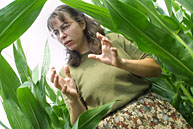Watching worms wend their way
Biologist Joann Whalen studies the seasonal migrations of animals. If she studied elephants her life would be a lot simpler. There are certain advantages to working with species you can spot from a helicopter or track from a land rover.
 Professor Joann Whalen in the field
Professor Joann Whalen in the fieldPhoto: Owen Egan |
|
But Whalen, a professor with the McGill School of Environment and the Department of Natural Resource Sciences, studies earthworms, and this presents several unique challenges such as convincing anyone that the movement of worms is something we ought to know about. Whalen explains that the importance of her work stems from the way earthworms help farmers by improving soil. By tunnelling through the soil they improve aeration, while mixing organic-rich surface layers with mineral subsoils. Their faeces (called casts) are just about the perfect growing medium for plants. These humble dirt-eaters have a profound influence on nearly everything that happens below ground.
Despite this, earthworms are totally ignored when it comes time to calculate fertilizer inputs for a crop field. This is because it's nearly impossible to quantify the benefits of earthworms in an open field. "Most of what we know about worms comes from laboratory and greenhouse experiments, and it is very difficult to take those results and apply them to the real world" explains Whalen. "We know that earthworms alter soil nutrient levels; we know that plant growth depends on soil nutrient levels; but we haven't been able to show a direct link between earthworms and plant growth in the field."
The challenge is the scale of the problem. It's easy to measure the impact of a dozen worms living in a pot on a laboratory bench. It's nearly impossible to measure the impact of a half-million worms burrowing through a hectare of soil. A common approach is to carefully study a very small sample of soil, and then to extrapolate the results upwards to estimate the overall impact on a field. Charles Darwin was one of the first scientists to use this technique. By his calculations, 500,000 worms, each consuming 50 grams of organic matter, will eat their way through 25,000 kilograms of soil in a field the size of a soccer pitch each year.
These numbers are a good indication of just how important earthworms are, but don't necessarily help farmers in their management plans. "Worms move. They aren't evenly spaced throughout a field -- they aggregate together. We can't predict where the earthworms are going to be: are they attracted to certain soil conditions, or are they moving around at random?" Until we know where and when the worms are active in a field, we won't be able to take full advantage of their behaviour.
Using these arguments, Whalen convinced the Natural Sciences and Engineering Research Council to support her study. Now she has the funding, all she has to do is find the worms. "Radio tracking equipment is just too big" she notes, so she'll have to resort to a low-tech solution.
Armed with a shovel and a bucket Whalen and her graduate students will have to dig up the worms by hand. Each of her six quarter-hectare plots will be randomly sampled throughout the growing season of four years. While they collect the earthworms, they'll also be taking soil samples. The resulting data should shed some light on just what it is the worms are looking for as they wander through the earth.
She'll be able to map the distribution of earthworm populations, but not to follow the travels of individual worms, which would require her to be able to recognize each one. But sadly, even for a worm specialist like Whalen, they all look pretty much the same. She is exploring a novel approach however: "I've been looking into tattooing them."
Besides the applications of this research for farmers, it could also be valuable to conservation biologists. As common as they are, earthworms aren't Canadian. They are invasive species, like the notorious zebra mussels that have taken over large areas of the Great Lakes. All the Canadian worms were killed off by the glaciers that covered the country until the end of the last ice age, 10,000 years ago (the few remaining native North American worms haven't yet migrated back into the north). So Canadian forests have developed worm free. Scientists are only now beginning to realize that the worms that crossed the Atlantic with the settlers may be having a significant impact on Canadian ecosystems.
Plants that evolved in worm-free forests had to adapt to poor soils and the thick layer of dead leaves that worms are so good at breaking down. A recent study from northern Minnesota has shown that one such plant species, the goblin fern, may no longer be able to live in forests that have been invaded by worms.
Whalen's study will include natural forests as well as agricultural fields, and she will be one of the first scientists to explore the relationship between earthworms and native plant communities. Under-standing how earthworms move through forest soils may be key to protecting the biodiversity of those habitats.
Would Whalen's life have been easier had she chosen to study elephants? Probably, but Canadian farmers and conservationists should be glad she set her sights a little lower down the food chain.
McGill's SPARK program (Students Promoting Awareness of Research Knowledge) is funded by NSERC (Natural Sciences and Engineering Research Council of Canada) and run by the Faculty of Education, VP Research Office, and the University Relations Office.

